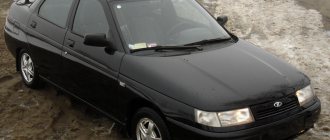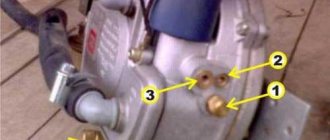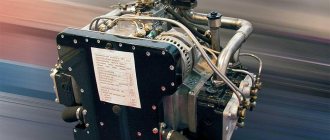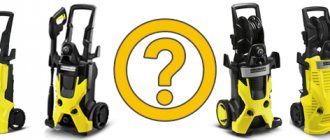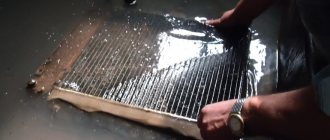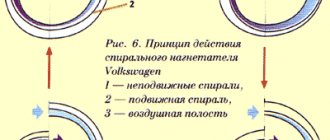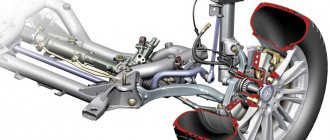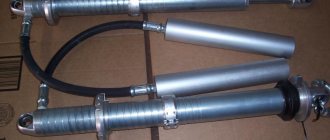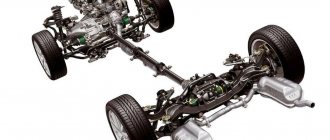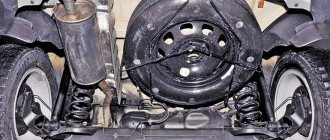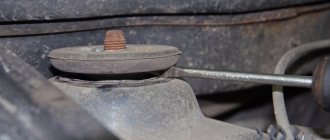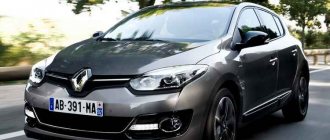Hydraulic suspension
Hydraulic suspension ⭐ is a type of suspension that provides regulation of the level of the body relative to the road through the use of hydraulic elastic elements.
In hydraulic suspension, instead of shock absorbers, hydraulic struts or hydraulic lifters with a very large working stroke are used. Special balls or hydrospheres are screwed onto the upper end of each rack, which act as springs; they are also called “boules”. They are designed extremely simply: the cavity inside the sphere is divided into two parts by an elastic membrane, on one side the sphere is filled with nitrogen (pressure from 35 to 60 atmospheres), and on the other side the membrane is supported by special oil (LHM or LHM+ for DS, CX, GS, BX , XM, Xantia, for Citroen C5, C6 LDS is used - orange) acrid green color.
As you know, when loaded, the vehicle's ground clearance decreases. To avoid this, self-adjusting rear suspension systems can be used. The figure shows the layout of a hydraulic suspension with automatic adjustment of the constant level of the car body.
Rice. Suspension layout with automatic adjustment of the constant level of the body of a passenger car: 1 – two-stage pump to ensure the operation of the power steering and adjust the constant level of the body; 2 – control unit; 3 – storage devices (hydraulic accumulators); 4 – braking force regulator; 5 – tank for working fluid
In cars with self-regulating rear suspension, a special reservoir 5 is provided with working fluid, which can be supplied to the rear shock absorbers. This fluid performs an auxiliary function to facilitate the action of coil springs when transporting heavy loads. The liquid is supplied to the accumulators 3 by a hydraulic pump 1. The system is controlled by a special unit 2 installed on the bottom of the car. The block is connected to the rear anti-roll bar and determines the vehicle's load based on the position of the stabilizer.
The principle of operation of the system is shown in the figure.
Rice. Operating principle of a system with hydraulic suspension: 1 – pump; 2 – piston of the drive mechanism; 3 – valve; 4 – bypass valve; 5 – jet; 6 – right cam; 7.10 – ball; 8 – safety valve; 9 – left cam; 11 – tank; 12 – spring; 13 – traction; a – neutral position of the body; b – top position of the body; c – lower position of the body
When the engine is running, the hydraulic pump supplies fluid to the control unit. Depending on the load inside the car, the shaft on which two cams 6 and 9 are mounted can rotate. The rotation of the shaft depends on the position of the rod 13, which in turn is connected to the rear stabilizer of the body.
If the car is not loaded, cam 9 turns, acts on ball 10 and it opens valve 3. In this case, the liquid returns from the shock absorber to the reservoir. In this position, the rear suspension is supported only by coil springs.
As soon as the car is loaded above a certain norm, cam 6 comes into operation, which pushes the piston of drive mechanism 2 to the upper position with the help of a ball and blocks the return line. Liquid from the accumulators and pump is supplied through bypass valve 4 to the shock absorber reservoirs. Pressure in the shock absorber reservoirs causes the shock absorbers to extend slightly, lifting the rear of the vehicle. As soon as the rear of the car rises to the desired height, safety valve 8 will return the fluid to the accumulator or reservoir.
With the body in a constant position in the middle position, the shock absorbers connected to valve 3 are isolated from the liquid system and liquid is pumped from the tank (storage) to the pump and again to the tank.
In this way, the level control unit maintains the height of the rear of the vehicle at the same level, regardless of the load.
The drives are equipped with a gas-filled chamber, which is separated from the liquid by a rubber diaphragm. This chamber allows the shock absorbers to function correctly, even when the accumulators are full. When pushed, the shock absorber is compressed and the fluid is pushed into the accumulator, deforming its diaphragm. As the shock absorber extends, fluid under diaphragm pressure is returned from the reservoir to the shock absorber.
The vehicle's ride height is changed by switching the control lever installed in the vehicle's interior. The lever is connected through actuator rods to the suspension height correctors. On models of early years of production, when the engine is turned off, the car lowers to the lower position. Later models are equipped with a one-way valve that isolates the suspension from the main hydraulic system, thereby avoiding this type of lowering of the body after the engine is stopped.
Operating principle of hydropneumatic suspension
The unit in question serves to automatically control ground clearance, adjust rigidity and force changes in these indicators. The clearance is adjusted taking into account the speed of movement, driving style and road surface. For example, at a speed of more than 110 km/h, the ground clearance is automatically reduced by 15 millimeters. On bad roads and low speeds (60 km/h or less), this parameter increases by 20 mm. It is worth noting that the height is maintained regardless of the load.
This possibility exists thanks to a special liquid circulating in the system circuit. This makes it possible to maintain a given level of the car body when driving on uneven roads.
The operation of the hydropneumatic suspension of the “+” category is distinguished by the fact that it automatically adjusts the stiffness depending on acceleration when cornering, during sharp braking and driving straight. The control unit takes into account vehicle speed, steering parameters and other aspects that change while driving.
The system automatically controls the solenoid stiffness valve, increasing or decreasing this indicator. Stiffness can change on a specific wheel or on all elements. The designers also provided for manual control of changes in ground clearance.
Hydraulic car suspension: why is it so convenient?
Greetings, dear car enthusiasts! I’ll immediately name the main character of our article - the hydro suspension of the car. Question: what, in your opinion, are the “tricks” of business and premium class cars?
Surely, for some it is the decoration and equipment of the interior, others are more attracted by the quality of materials and workmanship, but in any case, many of you will name the comfort that cars of the highest price category can give to their owners.
Comfort is expressed in the way the car handles and behaves, as well as in the fact that the car rides smoothly, absorbing almost all the bumps for which our roads are famous.
What should the happy owners of these cars be grateful for for their convenience? Answer: a special type of suspension plays a role in ensuring proper comfort, the heroine of our article is the hydropneumatic suspension of a car.
Hydractive suspension: complex, but very comfortable
Well, let's take a look inside the creation of Citroen engineers to find out its operating principle and secrets. Let's look at the design of the system using the third generation Hydractive suspension as an example. So, it consists of the following basic elements:
- front suspension struts;
- rear hydropneumatic cylinders;
- hardness regulators;
- hydroelectronic unit;
- control system.
The hydroelectronic unit is responsible for creating the required level of pressure of the special fluid in the system. To do this, a pump, a control unit and a series of valves are used that set the vehicle's ground clearance and prevent spontaneous lowering of the body after the engine is turned off and the power is turned off.
The front struts, as well as the rear hydropneumatic cylinders, have a similar design, but differ in location and angle of inclination relative to the body. Here it should be noted that, in fact, Hydractive technology is, as it were, integrated into the scheme of classic suspensions - it can be MacPherson struts in the front, and, for example, a double wishbone in the rear.
Elastic elements are used, of course, their own. Thus, the front struts consist of a hydraulic cylinder and a hydropneumatic elastic element, which are combined by a shock absorber valve.
The hydropneumatic element deserves special attention. This is a small metal sphere, inside which a membrane separates nitrogen gas (it is an elastic substance) and the working fluid of the system. There are six such balls in the third generation Hydractive suspension - one for each wheel and another one for the axle.
The more spheres, the wider the range of setting the suspension stiffness. To adjust the vehicle's height, hydraulic cylinders are needed. To do this, they are equipped with a piston, the rod of which rests on the suspension arm.
Stiffness regulators are parts whose name speaks for itself. They are installed one on each axis and contain that same additional elastic element-sphere. When a soft suspension is needed, with the help of valves all spheres in the car are connected together, which achieves maximum elasticity; in hard driving mode, the valve isolates the elastic elements from each other and the suspension becomes more flattened.
And, of course, the control system for this entire complex structure. Electronics, together with sensors, monitors the condition of the car and makes a decision - to make the suspension softer or stiffer, to raise or lower the car. By the way, all these operations can be carried out not only automatically, but also controlled by the driver.
As you have noticed, dear readers, hydropneumatic suspension is a rather complex system, which determines its price and application - hardly anyone will install it in a budget car.
This is where I end this article, but I am already preparing the next one, no less interesting, for publication.
Subscribe to the newsletter and don't miss the latest publications!
Hardness regulator
This part is designed to change the stiffness of the suspension. The regulator consists of a shock-absorbing and solenoid valve, a spool and an additional sphere. To achieve maximum softness, the unit allows the maximum internal volume of gas to be pumped. In this case, the solenoid valve is disconnected from the power supply.
When the solenoid valve is activated, the hydropneumatic suspension goes into hard mode. In this case, the rear cylinders, additional spheres and struts are isolated from each other.
Additional input devices of the system include sensors and mode switches. The Hydractive 3 type unit has sensors for measuring body height and steering angle. Another indicator monitors the speed and rotation of the steering wheel. The mode switch forcibly sets the height of the car and the stiffness of the suspension.
Lowrider or how to make a car jump and dance
Lowcar is an extremely low-slung car. Owners of tuned masterpieces strive to achieve an external effect, without attaching importance to technical characteristics. Lowcar is translated from English as “low car” .
In the States, a low-slung car is often called a “Lowrider,” which translates to “low rider . Low ground clearance is not the only difference between a low car and ordinary cars. The cars were painted in provocative colors with drawings or inscriptions, and equipped with extravagant accessories.
The use of hydraulic stretching in car body repair
- To start working, the hydraulic extension must be connected to the pump with a hose, the release valve must be closed by turning it clockwise as far as possible. Do not tighten the valve too much. The lever must be screwed to the pump handle. To release the pressure, you need to turn the valve valve counterclockwise. Do not unscrew the valve more than half a turn.
- The hydraulic pump can be positioned in any position, from horizontal to vertical, but the end of the pump hose should always be down when the pump is not positioned horizontally.
- Never exceed the load that the hydraulics can handle.
- Before using it, you need to measure the distances between the control points to determine the direction of application of the force. This can be a single or a series of sequential impacts, with a change in the position of the stretch.
- When using “hydraulics,” it is important to understand that pressure is generated at both ends at the same time. Thus, there may be a danger of deformation of an intact body element during its impact if the location of the stretcher is chosen incorrectly. Pressure can be applied locally or distributed over a large area by using special attachments or by placing hardwood blocks.
Repairing a dent
The procedure for using a stretcher with a rubber attachment on a large dent.
Do not press directly into the center of a large dent. When removing a large dent (for example, on a roof), the hydraulic tension should act around its outer edges, gradually moving from the periphery to the center, as when straightening a dent with a straightening hammer. This way the dent will gradually return to its original state. For this type of repair, a special rubber nozzle is used, which will eliminate additional deformation of the sheet metal when pressed. If the stretching action is directed directly to the deepest point of damage, without eliminating the tension around it, then folds will form and the metal will stretch, which will require additional straightening.
Using hydraulic stretching in openings
“Hydraulics” can be used in body openings to return geometric parameters to their original state. To do this, wooden blocks made of hard wood with a cut for edging, on which the brace will rest, or special clamps can be installed on the flanging of the openings.
Stretch pull in combination with chain
For a more effective effect, the stretch should be located at approximately 45 degrees, the angle of the chain with the floor should not be less than 90 degrees.
The illustration shows the wrong location. In this case, the force is directed upward, and not to pull out the damaged body. A hydraulic stretcher can be used in combination with a chain and clamp to pull out misaligned body parts. To do this, there must be a stop for its base and a fastening for the chain. Horizontal pulling using a chain and guy wire can be achieved by placing it at an angle of 45 degrees. To pull at an upward angle, the guy will be positioned vertically and requires lengthening with extension pipes.
The origin and development of lowriding
The lowrider movement originated in America in the 1930s, namely in Texas and Southern California, and gained considerable momentum. The “steepness” of the owner was measured in inverse proportion to the car’s ground clearance.
Fashion overcame common sense; owners of unique cars had difficulty moving along the highways of America. Airbrush equipment was used to cover the body part with various images. The drawings depicted scenes from the Latin American subculture and fragments of criminal life.
External accessories were covered with a thin layer of chrome or gold plated. The coating was applied to the engine, exhaust system, underbody and suspension. The wheel arches were equipped with neon lighting from the inside. Duplicate headlights were installed on the car, exhaust systems were shortened and installed on the side. The hoods were carved in the shape of the mouth of a crocodile or shark. Street craftsmen trimmed the springs of the suspension system. The car took on a phantasmagoric appearance.
Brothers Ron and Louis Aguirra invented a way to change ground clearance from the minimum allowable size to enormous values. They installed a hydraulic suspension of their own design on the Corvette using parts brought from a junkyard. So lowriding has risen to a whole new level.
Hydraulic
I generation
Since 1990, the Hydractive 1 suspension has been fitted as standard to a number of Citroen vehicles, including the Xantia and XM models. A feature of the first two generations was the combination of the hydraulic lines of the brake system, power steering and suspension into one common circuit.
Diagram of the Hydractive front suspension on a Citroen XM
Two modes were provided:
- Sport – rigid suspension mode for dynamic driving.
- Auto – a mode for automatically changing the suspension stiffness based on sensor readings that take into account the current driving parameters (gas pedal position sensor, steering wheel angle, brake pressure and others).
Systematization of lowcars
Since the late 70s, the low car has been associated with holiday shows. High cylinder pressure, innovative welding methods and improved frame reliability, effective air suspension allowed the car to jump and dance. Lowcars are differentiated by type.
- Traditionals and Classics Lowcars . Traditional cars are cars without hydraulics with low-mounted suspension, without tuning. Classic low cars are represented by passenger cars of the sedan or coupe class from the 60s to the 80s with high-quality hydraulics and stylish interior trim.
- Bombs. The bombs are represented by cars from the period 30 - 50 years. The name reflects the design of the car. Additional headlights, a low roof and visors over the windshield, side exhaust pipes, and the absence of bumpers gave the car an aggressive look.
- Euro . The style is emphasized by equipping it with expensive audio and video systems and chip tuning. Equipping with spoilers and large chrome wheels emphasizes the urban feel of the car.
- Minitrucks . The group is represented by trucks, off-road models, and pickups. A mandatory attribute of a Minitruck is a forced engine and low ground clearance. The use of a nitrogen supply system in the engine and the use of pneumatics in the suspension mechanism are not excluded.
- Transformers . Transformers contain hydraulics not only in the suspension system. The doors, hood, and trunk lid are equipped with hydraulic cylinders. Some show cars are not designed to drive fast. The transformer is equipped with various platforms and rotating mechanisms. The hood of a car can have a double structure and swing open like door leaves.
- Resto-Cal . Tuning requires a strict approach to the car brand. The only car that represents the style in its “pure” form is the air-cooled Volkswagen Beetle Characteristic features are lowered suspension, roof and hood racks. Swamp coolers, the predecessors of modern car air conditioners, are a fashionable accessory. “The front tires are very narrow, the rear tires are as wide as possible. The rear wheels have negative camber. The term "Resto" comes from the word "restoration", the prefix "Cal" indicates the origin (California).
Lowriding in Russia
Wealthy clients receive parts from America or Europe. Young people organized shows of tuned cars as evidence of folk craftsmanship. Low ground clearance was often achieved by shortening the shock absorber springs. The first lowcar that met the style requirements was the Volga-2477. The car was produced in Belgium in 1980 and tuned in Russia. In 2010, the first lowrider club in Russia was organized, which united owners, craftsmen and simply lowriding lovers.
In addition to the Volga, amateurs convert Zhigulis into lowcars. Favorite foreign lowrider models are Chevrolet Monte Carlo and Oldsmobile Cutlass Supreme. In the class of trucks, Chevy and Ford are tuned for lowcars.
Let's make the car jump and dance
To get a Dancer , or dancing car , a special suspension is used. For a dancing car, pneumatic shock absorbers are used. These are elastic rubber pneumatic elements filled with compressed air. As the pressure increases, the volume increases, allowing the ride height to be adjusted. The source of compressed air is a receiver into which air is pumped by a compressor.
Components:
- Pneumatic elements with air supply valves.
- Receiver.
- Compressor.
- Remote control.
When turning, such a car does not roll and does not stick its nose into the surface when braking.
- Cheapness.
- Reliability.
- Easy to install and maintain.
- Powered by car battery.
To equip such a suspension, conventional shock absorbers are replaced with pneumatic elements, acquiring the remaining components of the system.
The hydraulic suspension, a lowrider's dream, allows the car to bounce along the road.
Installation of hydraulics requires preparation:
- Electric pumps for pumping liquid.
- Additional batteries.
- Hydraulic cylinders for raising the body.
- Pipeline with valve systems.
- Body bumpers.
- Hydraulic accumulators for smooth running.
- Additional batteries.
- Remote Control.
The hydraulic kit allows the car to compete in low car jumping competitions. Competitions are controlled remotely from consoles.
A car with hydraulic suspension can change ground clearance and sway without losing balance. Calculation of parameters allows you to select the suspension to suit the needs of the car owner.
Key elements of the Hydractive suspension
A modern Hydractive system consists of the following main elements:
- Hydroelectronic control unit - hydrotronic (1), which regulates the pressure and amount of fluid in the system.
- Front (2) and rear (5) hydropneumatic elements that perform the function of damping and elastic suspension elements.
- Front (3) and rear (6) additional hydropneumatic spheres that regulate suspension stiffness.
- Front (4) and rear (7) body height sensors.
- Built-in interface (8).
- Steering wheel position sensor (9).
- Expansion tank with liquid (10).
- Accelerator pedal (11).
- Brake pedal (12).
Which is better: air suspension, hydraulic or conventional? Let's find out!
A car suspension is a key element of the chassis of any car, as well as the most important factor in the issue of comfort of movement. It is the suspension that is responsible for how and at what speed you will move over uneven surfaces.
In addition, the maneuverability and controllability of the car depend on the suspension. Even the most powerful car without the “correct” suspension and the same setup is just a “semi-finished product”.
The evolution of the suspension is no less impressive than the evolution of modern internal combustion engines. From a few springs and bolts, it has turned into a complex system that includes dozens, and sometimes hundreds of different parts, which are often electronically controlled. Today, there are three main types of suspension: conventional (classic spring) suspension, air suspension (pneumatic), and hydraulic suspension (hydraulic suspension).
In most cases, the question “which suspension is better” does not arise, everyone buys a car that they can “afford”, but the price of the car and its class already by default provide for all the “best”, this also applies to the suspension. In general, the question of what is better “pneuma”, “hydra” or “springs” can be answered quite quickly and simply, just look at what is installed on expensive premium cars. And they usually have air suspension. However, this article will talk about something a little different; we will look at the positive and negative aspects of each of the candidates in order to understand what suits each of us better.
So, let's begin. As standard, most cars are equipped with a spring, classic suspension, which is the best option in terms of the ratio of reliability and cost of maintenance. Air suspension can be found on expensive cars or in the “additional options” section for a particular car. Hydraulic suspension is an analogue of “pneuma”, only it uses liquid instead of air. Hydraulic suspension, as you understand, is not installed on “regular” budget cars.
Spring suspension
This option is the most popular and is found, perhaps, on 9 out of 10 cars, although I could be wrong with the ratio. This option is good because it is structurally quite simple; many people service their car’s suspension themselves, since by and large there is nothing complicated there. Spare parts are inexpensive when compared with spare parts for pneuma, and no special equipment is required for operation. The design has been tested for decades on both small cars and large SUVs. The system of levers, shock absorbers and springs works smoothly and without failure, providing the car with excellent driving performance and comfortable travel for passengers.
Air suspension
Since the “zero”, air spring suspension has become the hallmark of all S-class cars. Every car on TOP luxury sedans and SUVs. It is much more difficult to find a business class with such a suspension; it could be some kind of individual configuration or special order. As for state employees “for the people”, it’s rather wild to find air suspension here.
The role of springs in air suspensions is performed by elastic air cylinders, usually made of dense rubber. The main advantage of pneuma is its versatility; by changing the pressure in the cylinders, the driver can select the desired mode of operation of the suspension. Moreover, such cylinders allow you to increase or decrease the vehicle’s ground clearance, for off-road driving or on a flat road. It is for these qualities that air suspension is so valued all over the world. Such pneumatic struts can be installed in a circle or only at the front/rear.
However, such uniqueness and versatility comes at a price in the most literal sense. Firstly, you will overpay immediately when buying a car, since the system is expensive, all its components are not cheap, this ultimately affects the overall price tag of the car. In addition, everything “complex and sophisticated”, as a rule, is not durable, therefore, unlike springs, pneuma does not “live” long. And if we are talking about operation “with us”, then the air suspension is more of a disadvantage than a plus. Driving on bad roads, untimely maintenance, reagents on the roads - all this leads to the fact that the air suspension of the Russian consumer fails very quickly, and at the same time it hits the pocket quite seriously. As a result, some simply refuse such cars, others convert the pneuma to springs, and there are those who spend a lot of money and still repair it.
Repairing a suspension with air springs will cost several times more than the classic version. Even if you buy non-original spare parts, restoration will make you take a fresh look at this suspension option and re-evaluate your values.
Read more about the pros and cons of air suspension in this article.
TRUCK SUSPENSION
The suspension of a modern (truck) car consists of three main components: 1. Elastic elements that absorb dynamic loads between the body or frame of the car and the road surface. 2. Elements that dampen suspension vibrations. 3. The unit responsible for stabilizing the car relative to the plane of the road.
At the moment, trucks use a variety of vehicle suspension designs and engineering solutions for elastic elements. First of all, these are the car tires themselves, which effectively absorb small unevenness in the road surface. The larger the wheel and the less pressure in it, the greater the obstacle the car overcomes without much load on the frame. Heavy-duty mining dump trucks with their huge wheels generally do without additional suspension elements, since their tires effectively dampen road irregularities. Low-speed wheeled tractors and special equipment in the form of an elastic element are content only with air in the tires.
The second oldest and most frequently used elastic elements on modern technology are springs. They come in different designs and have different manufacturing technologies, but they are the ones most widely used on modern trucks, and they can be found both on long-haul tractors and on construction equipment, city delivery vehicles, military and racing trucks. If earlier thick packages of short leaf springs were installed on trucks, then on modern vehicles the number of springs has been significantly reduced, down to one on some models, and the length has been increased, which has improved the smoothness of the ride and reduced the weight of the structure. While European manufacturers prefer long springs, their US counterparts prefer short ones. Therefore, trucks from the North American continent are more rigid on the move.
Air suspension became widespread in Europe and the USA 30-40 years ago. Its main advantage compared to a leaf spring is that it weighs less, its consumables are cheaper, and the truck has a better ride. The factory price of a truck with air suspension is higher than a vehicle with a leaf spring, but replacing a cushion during operation is cheaper than a whole spring. In addition, trucks with air suspension are less likely to break up the asphalt of roads, which is why long-haul tractors are most often equipped with air springs. The disadvantage of such a suspension is that it requires additional air valves and pipes and a more powerful air compressor. This system is afraid of moisture and road dirt, which is why spring suspension is often used on construction equipment. True, there are Dutch manufacturers of heavy construction equipment Terberg and Ginaf, which actively use air suspension of their own design on dump trucks.
Air springs do not have a rigid connection with the truck frame, and to prevent the bridge from “walking,” longitudinal and transverse reaction rods are used in the design of the vehicle’s suspension. This also complicates and increases the cost of the design.
In the case of using a four-balloon bridge suspension scheme, in addition to two (usually) longitudinal reaction rods, the installation of a transverse (usually V-shaped) rod is required. If a manufacturer installs two air springs on an axle, then beam springs (correctly called reaction rods) are used in the suspension design. The rigidity of the structure increases, then the transverse rod is installed alone or completely dispensed with. It is the silent blocks and torque rod bushings that require attention and periodic repair and replacement. On normal European roads, traction lasts 250-350 thousand km. In our conditions, they are unlikely to be enough for more than 200 thousand km. If you missed the moment of replacing the jet thrust, then you can “get” to repair the crosspieces, unless, of course, earlier the moment of force, which does not coincide with the axis of the road train due to broken bushings, does not turn your truck across the road on ice.
It should be noted that modern manufacturers of trucks widely use a combined suspension consisting of springs and pneumatic elements.
On the North American continent, solid rubber cushions are widely used on construction equipment as an elastic element. Such a suspension is much lighter than a spring suspension, and it does not have the disadvantages inherent in an air suspension. The price of a rubber suspension is not much different from a spring suspension. But it is quite rigid, and the driver cannot do without air suspension. Unfortunately, this type of suspension is almost not common in Europe.
Torsion bars are used mainly on military equipment. True, on the famous Tatra trucks in some construction models, torsion bars are widely used both independently and in combination with air springs. On light delivery trucks from Japanese and Korean manufacturers, the front independent suspension is sometimes equipped with torsion bars.
Springs are used mainly on all-wheel drive off-road vehicles with independent wheel suspension. The German army has a sufficient number of MAN trucks with a 6x6 wheel arrangement and independent spring suspension on all wheels.
In order to dampen the rocking of the truck, shock absorbers are used in the vehicle design. They can be either single- or double-acting. At the moment, shock absorbers are usually hydraulic. On European autobahns and in the European climate, shock absorbers “live” 300-400 thousand km. On our roads, the load on the suspension increases several times. Russian potholes and frosts can “kill” shock absorbers even after 10 thousand km: they leak, rubber bushings break, or “ears” come off.
Sports trucks, special purpose vehicles and military equipment are equipped with hydropneumatic struts. This is not a new invention, as they have been used on military equipment for a long time. But relatively recently, these racks began to be used on civilian vehicles.
Hydropneumatic struts are a kind of active shock absorbers that effectively absorb increased loads and dampen large-amplitude vibrations. They can change their rigidity and other characteristics depending on operating conditions. They are usually used on trucks with leaf spring suspension. Such vehicles with such suspension can withstand ski jumps and flights of several tens of meters without consequences for the truck. The Russian KamAZ-4911 excellently demonstrated the capabilities of such a suspension at various rally raids and demonstrations of military equipment.
Over the past two years, hydropneumatic struts of a new generation have begun to be installed on special vehicles and not only on them. Now they serve not only as vibration dampers, but also as an elastic element. A truck with such a stance does not require any leaf springs, springs, or torsion bars. This greatly simplifies the design. The characteristics of such hydropneumatic struts can be changed from the cab, varying the ground clearance, stiffness, suspension travel, and even tilting the car left-right or back-and-forth. Such racks fit well into the design of a car with independent wheel suspension, and such an all-terrain vehicle is no longer in danger of the wheels hanging diagonally in difficult road conditions. Manufacturers such as Ginaf and Terberg have begun installing new generation hydropneumatic struts on their equipment. Manufacturers of trailed equipment on semi-trailer suspensions are currently offering these racks timidly. Most likely, this design will become more widespread and more widely used.
The third, mandatory element of the suspension that needs to be mentioned is the longitudinal and lateral stability stabilizers (roll stabilizers). Their main task is to align the car relative to the plane of the road when the latter rolls and ensure the tightest possible contact of the wheel with the road. If previously stabilizers were installed on spring trucks only on the front axle, then due to the increase in speeds and loads, the next step was their widespread use on drive axles. The weak link of the stabilizers is the plastic bushings, which require periodic replacement and maintenance. In Russian conditions, they do not nurse more than 200 thousand km. You can do without them, but, as my experience shows, in this case, jet rods, spring pins, and the rest are subject to increased wear.
If five years ago, anti-roll bars were mandatory on axles with air suspension, the introduction of electronics in modern trucks has made it possible to abandon the iron structures of stabilizers. Now the electronics monitor this and, by dispersing air in the air cylinders, even out the roll of the car. The same functions are performed by the new generation of hydropneumatic struts.
The world of truck suspension is very diverse, and the use of certain types depends on the purpose of the vehicle, the national mentality and the client’s wallet.
But in this article we tried to consider the most common options most often found on the roads, and talked a little about promising developments that, quite possibly, will appear on commercial vehicles in the near future. Share
Hydraulic suspension
This type of suspension was invented by the French back in the 50s. Then Citroen decided to improve the car's suspension and created its own version - a hydropneumatic system, which, by the way, was the main feature of the company for several decades. The latest representative of the “French” with hydraulic suspension is the Citroen C5, the driving characteristics are many times different from a car with a conventional spring suspension. Hydropneumatics is a kind of “hybrid”, which is a mixture of classic and air suspension. However, in addition to air, as is already clear from the name, liquid is also used. Hydraulic fluid allows you to change suspension parameters in the same way as pneuma, but unlike the latter, the French hybrid suspension is considered more reliable and maintainable. In general, hydropneumatic suspension in terms of maintenance cost is somewhere in the middle between “pneumatic” and “springs”. As for reliability, here too this option will be a compromise between the first two contenders.
However, despite all the advantages of this suspension, it has not found widespread use. Moreover, Citroen itself does not use it en masse; instead, the company’s cars are equipped with springs and a pneumatic analogue.
Device and principle of operation
A hydraulic stretcher consists of 3 basic elements: a pump (pump), the stretcher itself, and a flexible high-pressure hose connecting the pump to the stretcher.
The pump includes a reservoir and a pump handle. The hydraulic pump contains oil. When inflated by a pump, the cylinder creates pressure and pushes oil through the hose, filling the extension, and pushes the cylinder. The hand pump applies enough pressure to overcome the external resistance acting on the retractable piston. When the pump handle has to be applied with force, this indicates that the “hydraulics” have reached their limit.
When the piston reaches its maximum length, the oil is released back into the pump reservoir through a special valve, so as not to squeeze out the piston more than it should be and not spoil the “hydraulics”. The stretch is intended for pulling action only. It should not be used to hold pressure under load for too long. It has a fixation system for attaching pipes that increase its length and various attachments included in the kit.
What's the result?
Which option to choose is something everyone must decide for themselves. There is no consensus, and that's normal. If we talk from the point of view of comfort and convenience, then, of course, the air suspension is unrivaled. But it has a number of disadvantages: it is short-lived and very expensive to maintain and repair. If the goal is to get a budget option, it is better to choose a classic spring suspension. This one will be inexpensive to maintain and you can repair it yourself. In addition, such a pendant will serve as truth and faith for about 100-150 thousand. Unfortunately, a hydraulic analog is extremely rare, and on cars that are far from new, so, in principle, there is no point in considering it. And the choice, as always, is yours.
Thank you for your attention, see you again on Question Auto. If you liked the article, share the link to it with your friends on social media. networks using the special buttons below. We will also be grateful for your comments, it is very important for us to know your opinion.
Device
Each pendant contains the following components:
- Elastic device. Takes on the loads provided by road obstacles. May consist of a spring, pneumatic elements, etc.
- Damping device. It is necessary to dampen body vibration when overcoming road irregularities. All types of shock-absorbing devices are used as this device.
- Guiding device. Controls the required displacement of the wheel relative to the body body. It is made in the form of transverse rods, levers and springs.
- Anti-roll bar. Suppresses body tilts in the transverse direction.
- Rubber-metal hinges. Serve for elastic connection of parts of the mechanism with the machine. Additionally, to a small extent they act as shock absorbers - they partially dampen shocks and vibrations.
- Suspension travel limiters. The movement of the device is recorded at the critical lower and critical upper points.
